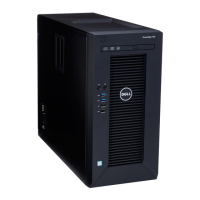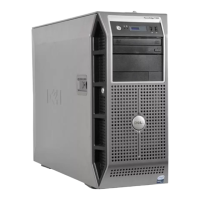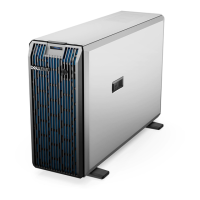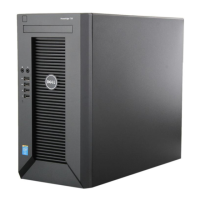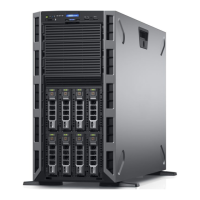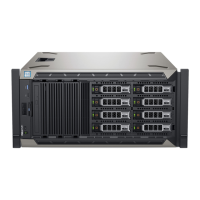



Do you have a question about the Dell PowerEdge T320 and is the answer not in the manual?
Details front panel components, buttons, and indicators for tower and rack modes.
Explains the LCD panel, its navigation, and how it displays system status and error messages.
Details back panel connectors, power supplies, and expansion slots for system connectivity.
Describes NIC indicator codes, power supply status, and hard-drive indicator patterns for diagnostics.
Guides users through entering System Setup, understanding boot modes, and navigating BIOS options.
Overviews key configuration menus like System Information, Memory, Processor, Security, and Devices.
Details how to access and configure iDRAC settings for remote system management and thermal controls.
Instructions for installing/removing front bezel, feet, wheels, optical/tape drives, and hard drives.
Procedures for installing/removing memory modules and cooling fans for system maintenance and upgrades.
Guides for installing/replacing processors, redundant/non-redundant power supplies, and related boards.
Steps for installing/removing PCIe cards, GPU cards, iDRAC ports, SD modules, and the system board.
Instructions for replacing the system battery and servicing the control panel assembly, including LCD/VGA modules.
Steps and safety precautions for converting the system from tower mode to rack mount configuration.
Step-by-step guides for resolving common system problems like startup failures, USB, NIC, and power issues.
Explains how to use Dell Online and Embedded System Diagnostics for hardware testing and problem identification.
Lists and explains system error, warning, and alert messages for diagnosing issues and troubleshooting.
Provides detailed specifications for processor, memory, drives, connectors, and environmental factors.
Information on how to access online support, documentation, and contact Dell for assistance.
Details front panel components, buttons, and indicators for tower and rack modes.
Explains the LCD panel, its navigation, and how it displays system status and error messages.
Details back panel connectors, power supplies, and expansion slots for system connectivity.
Describes NIC indicator codes, power supply status, and hard-drive indicator patterns for diagnostics.
Guides users through entering System Setup, understanding boot modes, and navigating BIOS options.
Overviews key configuration menus like System Information, Memory, Processor, Security, and Devices.
Details how to access and configure iDRAC settings for remote system management and thermal controls.
Instructions for installing/removing front bezel, feet, wheels, optical/tape drives, and hard drives.
Procedures for installing/removing memory modules and cooling fans for system maintenance and upgrades.
Guides for installing/replacing processors, redundant/non-redundant power supplies, and related boards.
Steps for installing/removing PCIe cards, GPU cards, iDRAC ports, SD modules, and the system board.
Instructions for replacing the system battery and servicing the control panel assembly, including LCD/VGA modules.
Steps and safety precautions for converting the system from tower mode to rack mount configuration.
Step-by-step guides for resolving common system problems like startup failures, USB, NIC, and power issues.
Explains how to use Dell Online and Embedded System Diagnostics for hardware testing and problem identification.
Lists and explains system error, warning, and alert messages for diagnosing issues and troubleshooting.
Provides detailed specifications for processor, memory, drives, connectors, and environmental factors.
Information on how to access online support, documentation, and contact Dell for assistance.
| Power supply input frequency | 50 - 60 Hz |
|---|---|
| Number of main power supplies | 1 |
| Redundant power supply (RPS) support | Yes |
| Chassis type | Tower (5U) |
| HDD size | - \ |
| HDD interface | - |
| Optical drive type | No |
| Supported HDD sizes | 3.5 \ |
| Total storage capacity | 0 GB |
| Maximum storage capacity | 32 TB |
| Number of HDDs installed | 0 |
| Number of HDDs supported | 8 |
| Supported storage drive interfaces | SAS, Serial ATA III |
| Compatible operating systems | Microsoft Windows Server 2012 Microsoft Windows Server 2012 Essentials Microsoft Windows Server 2008 R2 SP1, x64 (with Hyper-V version 2) Novell SUSE Linux Enterprise Server Red Hat Enterprise Linux Citrix XenServer VMware vSphere ESX and ESXi Red Hat Enterprise Virtualization |
| Memory slots | 6x DIMM |
| Internal memory | 4 GB |
| Memory clock speed | 1600 MHz |
| Internal memory type | DDR3-SDRAM |
| Maximum internal memory | 192 GB |
| Memory layout (slots x size) | 1 x 4 GB |
| BIOS type | UEFI |
| Performance management | IPMI 2.0, Dell OpenManage |
| Trusted Platform Module (TPM) version | 1.2 |
| Tcase | 76 °C |
| Bus type | QPI |
| Stepping | S1 |
| Scalability | 2S |
| Processor code | SR1AK |
| Processor cache | 10 MB |
| Processor cores | 4 |
| Processor model | E5-2407V2 |
| System bus rate | 6.4 GT/s |
| Processor series | Intel Xeon E5-2400 v2 |
| Processor socket | LGA 1356 (Socket B2) |
| Processor codename | Ivy Bridge EN |
| Motherboard chipset | Intel® C602 |
| Processor frequency | 2.4 GHz |
| Processor cache type | Smart Cache |
| Processor lithography | 22 nm |
| Processor manufacturer | Intel |
| Processor package size | 45 x 42.5 mm |
| Processor front side bus | - MHz |
| Processor boost frequency | The turbo boost is an automatic, managed accelleration of the processor when one of the cores is overloaded. |
| Processor operating modes | 64-bit |
| PCI Express configurations | x4, x8, x16 |
| Supported instruction sets | AVX |
| Thermal Design Power (TDP) | 80 W |
| Compatible processor series | Intel® Pentium® |
| Maximum number of PCI Express lanes | 24 |
| Memory channels supported by processor | Triple |
| Memory clock speeds supported by processor | 800, 1066, 1333 MHz |
| Memory bandwidth supported by processor (max) | 32 GB/s |
| Maximum internal memory supported by processor | 384 GB |
| Display | LCD |
| Graphics card | G200 |
| Graphics card family | Matrox |
| Maximum graphics card memory | 16 MB |
| LAN controller | Broadcom 5720 |
| Cabling technology | 10/100/1000Base-T(X) |
| Ethernet interface type | Gigabit Ethernet |
| USB 2.0 ports quantity | USB 2.0 ports have a data transmission speed of 480 Mbps, and are backwards compatible with USB 1.1 ports. You can connect all kinds of peripheral devices to them. |
| Ethernet LAN (RJ-45) ports | 2 |
| Sustainability certificates | ENERGY STAR |
| PCI Express slots version | 3.0 |
| Cables included | AC |
| Operating altitude | -15.2 - 3048 m |
| Non-operating altitude | -15.2 - 12000 m |
| Storage temperature (T-T) | -40 - 65 °C |
| Operating temperature (T-T) | 10 - 35 °C |
| Storage relative humidity (H-H) | 5 - 95 % |
| Operating relative humidity (H-H) | 10 - 80 % |
| Processor ARK ID | 75782 |
| Intel Secure Key Technology version | 1.00 |
| Intel Identity Protection Technology version | 0.00 |
| Depth | 542.2 mm |
|---|---|
| Width | 218 mm |
| Height | 430.3 mm |
| Weight | 29550 g |
